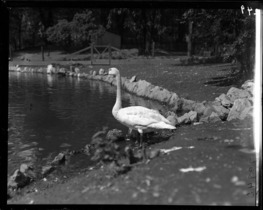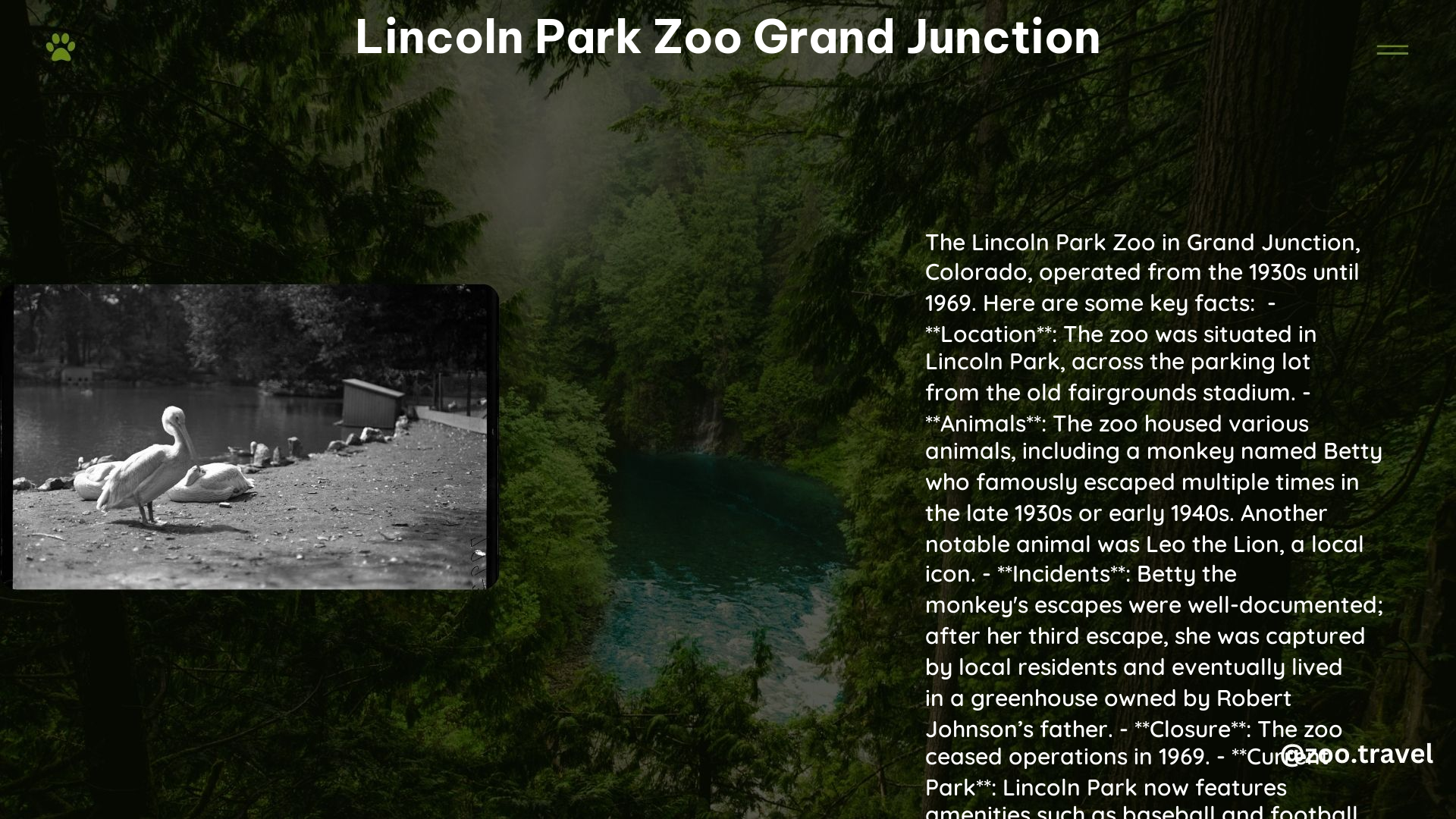The Lincoln Park Zoo in Grand Junction, Colorado, was a beloved local attraction that operated from the late 1920s until 1969. Founded to house a howling ape named Jo-Jo, it grew to include various animals like lions, monkeys, bears, and big cats. The zoo’s simple enclosures and nightly lion roars became iconic features of the community. Despite its closure due to outdated facilities, the zoo’s legacy lives on in local memories and stories of its famous residents.
What Was the Origin of Lincoln Park Zoo Grand Junction?

The Lincoln Park Zoo in Grand Junction had humble beginnings rooted in an unexpected arrival. In the late 1920s, the city found itself in possession of a howling ape named Jo-Jo. This peculiar situation prompted the establishment of a small zoo to house the primate, marking the birth of what would become a cherished local institution.
As the zoo grew, it began to acquire more animals, each with its own story. One of the most significant additions came in 1936 when the city traded five monkeys for a lion named Leo. This trade would shape the zoo’s identity for years to come.
Who Were the Famous Animal Residents of the Zoo?

Leo the Lion: The Roaring Icon
Leo the Lion quickly became the star attraction of Lincoln Park Zoo. His nightly roars echoed through the city, becoming a familiar and comforting sound for Grand Junction residents. Leo’s popularity was so immense that after his death, the zoo acquired a female lion and her two cubs to fill the void he left behind.
Betty the Monkey: The Great Escape Artist
While Leo was the zoo’s most famous resident, Betty the monkey gained notoriety for her daring escapes. Her adventures captivated the local community and led to an unusual turn of events:
- Betty escaped from the zoo multiple times.
- On her final escape, she took up residence in the trees and on the roof of a prominent water lawyer’s home.
- Local children, including Bill Ela, Al Look Jr., and Robert “Bob” Johnson, set traps to capture her.
- After successfully catching Betty, the zoo refused to take her back.
- The children built an enclosure for her in a greenhouse, where she lived for many years.
- Betty even bred with another monkey, producing offspring in her new home.
What Other Animals Called Lincoln Park Zoo Home?
The zoo housed a diverse array of animals during its operational years:
- Bears
- Bobcats
- Mountain Lions
- Various species of monkeys
When the zoo closed in 1969, many of these animals were relocated to other facilities, primarily the zoo in Delta, Colorado.
How Did the Zoo’s Exhibits Compare to Modern Standards?
By today’s standards, the exhibits at Lincoln Park Zoo would be considered outdated and inadequate. The enclosures were typical of the era but lacked the naturalistic habitats and enrichment features found in contemporary zoos:
| Feature | Description |
|---|---|
| Cages | Constructed with steel bars |
| Fencing | Primarily chain link |
| Flooring | Concrete floors in most enclosures |
| Habitat Design | Minimal natural elements or enrichment |
These simple enclosures, while common for the time, did not provide the animals with the stimulating environments that modern zoos strive to create.
What Led to the Closure of Lincoln Park Zoo Grand Junction?
Several factors contributed to the zoo’s closure in 1969:
- Outdated Facilities: The zoo’s enclosures were becoming increasingly inadequate for the animals’ needs.
- Health Concerns: The second Leo the Lion died from cancer, raising questions about the animals’ well-being.
- Expansion Challenges: The need for larger, more suitable enclosures presented logistical and financial hurdles.
- Changing Standards: As zoological practices evolved, the facility struggled to keep pace with new animal care standards.
After a feasibility study, the Grand Junction city council made the difficult decision to close the zoo. The closure marked the end of an era for the community, but the memories of Lincoln Park Zoo continue to resonate with those who experienced its charms.
How Did the Zoo Impact the Grand Junction Community?
Lincoln Park Zoo played a significant role in shaping the cultural landscape of Grand Junction:
- Community Gathering Place: The zoo served as a popular destination for families and visitors.
- Educational Resource: It provided many residents with their first encounters with exotic animals.
- Source of Local Lore: Stories about the zoo’s animals, especially Leo and Betty, became part of the city’s folklore.
- Nightly Ritual: Leo’s roars became a comforting sound that many residents associated with home.
The zoo’s presence in Lincoln Park also contributed to the park’s status as a central recreational area for the city.
What Lessons Can Be Learned from Lincoln Park Zoo’s History?
The story of Lincoln Park Zoo offers several insights:
- Evolution of Animal Care: The zoo’s closure reflects the changing standards in animal welfare and habitat design.
- Community Attachment: The fondness with which former visitors recall the zoo demonstrates the strong emotional connections people form with local institutions.
- Adaptability: The need for zoos to evolve and adapt to new knowledge and societal expectations is evident.
- Historical Preservation: While the zoo no longer exists, its stories and impact have been preserved through local history initiatives.
How Is the Legacy of Lincoln Park Zoo Remembered Today?
Although the zoo closed over five decades ago, its memory lives on in Grand Junction:
- Local History Projects: Organizations like Mesa County Libraries have documented stories about the zoo and its animals.
- Oral Histories: Former visitors and residents share their memories of the zoo with younger generations.
- Media Coverage: Local news outlets occasionally feature retrospectives on the zoo and its place in Grand Junction’s history.
- Community Nostalgia: The zoo remains a topic of fond reminiscence among long-time residents.
These efforts ensure that the legacy of Lincoln Park Zoo continues to be a part of Grand Junction’s cultural heritage, even as the city has grown and changed since the zoo’s closure.
References:
1. PostIndependent.com – History: Cold Case 1954 — Leo the Lion
2. Mesa County Libraries – Betty the Monkey’s Escape from Grand Junction’s Lincoln Park Zoo
3. 99.9 KEKB – Remembering Grand Junction’s Zoo + Leo The Lion
